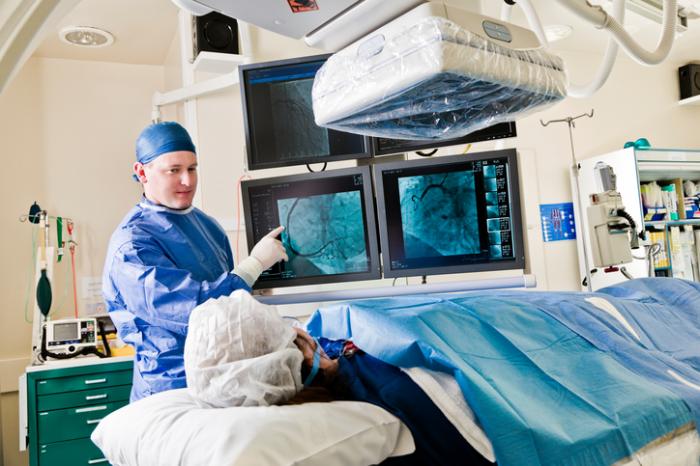Everything you’ve wanted to ask about Cardiology care, explained
Everything you’ve wanted to ask about Cardiology care, explained
Blog Article
Recognizing the Significance of Cardiology in Modern Healthcare Providers
Cardiology plays a vital duty in modern-day healthcare, particularly as heart problem continues to be the leading cause of mortality worldwide. Breakthroughs in diagnostics and therapy have changed individual treatment, allowing earlier interventions and improved outcomes. The shift towards preventive cardiology encourages individuals to handle their health and wellness proactively. As innovation continues to evolve, the assimilation of innovative solutions might even more redefine cardiology's impact on public wellness, motivating a closer exam of arising patterns and their ramifications.
The Frequency of Heart Disease and Its Effect On Public Wellness
Heart disease remains the leading reason of fatality internationally, its effect extends far past specific patients to influence public health and wellness systems and economic situations. The high frequency of heart illness places a substantial stress on health care resources, necessitating enhanced funding for recovery, prevention, and therapy programs. Public wellness initiatives should attend to risk variables such as excessive weight, cigarette smoking, and less active lifestyles, which contribute significantly to the rising occurrence of heart conditions.Moreover, the financial concern related to cardiovascular disease is enormous, including not only direct medical costs yet likewise indirect costs related to shed productivity and premature death. Areas face obstacles in taking care of these costs, typically leading to variations in health care access and end results. As the population ages and lifestyle-related risks remain to intensify, the seriousness for effective cardiology treatments comes to be critical. Attending to heart illness is not only an issue of individual wellness yet also a critical public wellness priority.
Advancements in Cardiac Diagnostics and Imaging Techniques
Current advancements in cardiac diagnostics and imaging techniques have actually changed the field of cardiology, enhancing the ability to detect and keep an eye on heart diseases. Methods such as heart MRI, CT angiography, and echocardiography have actually come to be increasingly innovative, offering comprehensive photos of heart frameworks and features. These modalities enable the very early recognition of problems like coronary artery condition, heart failing, and valvular disorders.Moreover, improvements in non-invasive diagnostics, such as wearable technology and remote monitoring tools, have encouraged people and doctor. These tools help with real-time tracking of heart rhythms and various other essential signs, causing prompt interventions. Furthermore, expert system is being incorporated into imaging evaluation, boosting accuracy and performance in diagnosis.
Developments in Treatment Alternatives for Heart Issues
Current innovations in cardiology have caused substantial technologies in treatment options for heart conditions. These consist of innovative medical methods that improve procedural outcomes and emerging medications that provide new methods for therapy. As the area advances, these innovations play an important duty in enhancing person treatment and results.
Advanced Surgical Techniques
Developments in medical strategies have actually transformed the landscape of cardiology, offering brand-new wish for clients with heart conditions. Minimally intrusive treatments, such as catheter-based treatments, have actually greatly lowered recuperation times and medical facility remains. Techniques like robotic-assisted surgery boost accuracy, permitting cosmetic surgeons to browse complicated anatomical frameworks with higher accuracy. Innovations in imaging innovation help with real-time visualization during procedures, enhancing results. Transcatheter aortic shutoff substitute (TAVR) exemplifies an advancement in treating aortic stenosis, enabling valve replacement without open-heart surgical procedure. Additionally, hybrid techniques that integrate surgical and catheter-based approaches supply tailored services for different cardiac concerns. These innovative surgical methods not only enhance person safety but also increase therapy options, underscoring the crucial role of advancement in contemporary cardiology methods.
Arising Therapies and drugs
As the landscape of cardiology remains to progress, arising treatments and medications play a critical duty in boosting therapy alternatives for heart problems. Technologies such as novel anticoagulants and progressed lipid-lowering agents have transformed the administration of heart diseases, significantly decreasing patient morbidity and mortality. In addition, the development of gene therapies and regenerative medicine uses encouraging opportunities for dealing with conditions previously regarded irreparable. Clinical trials are continuously revealing the efficacy of these treatments, pushing the limits of conventional therapies. Moreover, the assimilation of digital health technologies assists in customized medication, permitting tailored therapy strategies based upon genetic and lifestyle variables. Collectively, these advancements underscore the dynamic nature of cardiology, improving individual end results and redefining standards of treatment in modern health care.
The Role of Preventive Cardiology in Person Treatment
Preventive cardiology plays a necessary function in person treatment by concentrating on the identification of threat elements that add to cardiovascular disease. Through lifestyle alteration techniques and very early detection methods, doctor can properly minimize the incidence of cardiovascular events - Cardiology Jupiter. This proactive strategy not only boosts patient outcomes yet additionally advertises lasting health and wellness
Risk Element Identification
While heart diseases stay a leading reason for morbidity and death worldwide, efficient danger factor identification acts as a cornerstone of preventative cardiology. Determining threat factors such as hypertension, hyperlipidemia, household, and diabetes mellitus history is crucial for early treatment. Medical care professionals utilize various evaluating techniques to assess these factors, enabling for customized safety nets. Additionally, recognizing an individual's way of living options, such as smoking and physical inactivity, additionally educates risk analyses. This complete examination enables clinicians to develop individualized treatment plans aimed at mitigating risks. By focusing on risk factor recognition, healthcare systems can enhance individual results and decrease the general problem of heart diseases, ultimately adding to enhanced public wellness approaches and resource allotment.
Lifestyle Adjustment Methods
A multitude of researches highlights the vital role of way of living alteration strategies in lowering cardio disease threat. These approaches encompass dietary modifications, boosted physical activity, smoking cessation, and weight administration. By embracing a heart-healthy diet regimen abundant in fruits, vegetables, entire grains, and lean healthy proteins, people can reduce cholesterol levels and high blood pressure. Regular physical activity enhances the heart and improves general cardio health and wellness. Additionally, stopping cigarette smoking greatly minimizes the risk of cardiovascular disease and boosts recuperation prices for those with status quo. Weight administration additionally adds to cardiovascular health by minimizing other danger elements such as diabetes and high blood pressure. Carrying out these way of living changes not just advertises specific health but likewise acts as a cornerstone of preventative cardiology in individual treatment.
Early Detection Techniques
Way of life modifications substantially contribute to minimizing cardiovascular condition threats, yet they are most reliable when paired with very early detection strategies. Preventative cardiology emphasizes the importance of determining prospective heart issues before they escalate into major problems. Strategies such as blood pressure surveillance, cholesterol testing, and progressed imaging innovations like echocardiograms play essential roles in examining cardiovascular health and wellness. Biomarkers and genetic screening also boost the precision of early discovery, permitting customized preventative strategies. Regular heart risk evaluations equip doctor to interfere proactively, possibly preventing cardiac arrest and strokes (Cardiology Jupiter). By incorporating these early discovery techniques into regular care, people can gain from timely way of living treatments and targeted therapies, eventually boosting results and improving top quality of life
Integrating Technology Into Cardiology Practices
As developments in modern technology proceed to improve various areas, the integration of innovative devices and systems into cardiology techniques has actually come to be necessary for improving person treatment and outcomes. Telemedicine systems allow cardiologists to check patients from another location, enhancing access to care while decreasing the worry on healthcare facilities. Wearable gadgets, such as smartwatches, allow constant heart rate monitoring, alerting both patients and physicians to possible concerns in real-time. In addition, fabricated knowledge (AI) is being utilized to assess vast amounts of cardiac data, helping in very early diagnosis and personalized treatment plans. Advanced imaging techniques, consisting of 3D echocardiography, improve visualization of heart frameworks, leading to a lot more precise treatments. Digital health documents (EHRs) streamline person details monitoring, guaranteeing that cardiologists have prompt access to crucial information. Together, these technical advancements are transforming cardiology, promoting aggressive administration and enhanced wellness outcomes for individuals with cardiovascular conditions.
The Relevance of Person Education And Learning and Involvement
Person education and involvement play an essential duty in the management of cardio health. By outfitting people with knowledge regarding their problems, therapy choices, and way of life changes, healthcare carriers encourage people to take an energetic role in their treatment. This aggressive technique can result in boosted adherence to recommended medications, nutritional changes, and exercise programs, eventually reducing the threat of complications.Engagement also cultivates a strong patient-provider partnership, motivating open communication and depend on. When people feel notified and included, they are most likely to voice concerns and ask inquiries, which can cause far better medical outcomes. Additionally, instructional sources, such as workshops or electronic platforms, can enhance understanding and promote self-management approaches. Overall, prioritizing individual education and involvement is important for enhancing cardiovascular wellness, boosting lifestyle, and minimizing health care prices linked with heart diseases.
Future Patterns in Cardiology and Their Possible Influence

Often Asked Concerns
What Way Of Living Changes Can Minimize Heart Condition Threat?
The existing question addresses lifestyle adjustments that can substantially lower cardiovascular disease risk. Cardiologist website here near me. Embracing a balanced diet regimen, participating in normal exercise, maintaining a healthy weight, managing stress and anxiety, and preventing tobacco can notably boost cardio wellness
Exactly How Can I Identify Very Early Indications of Heart Troubles?
Recognizing very early indications of heart troubles includes tracking signs such go to website as upper body pain, lack of breath, fatigue, and uneven heartbeat. Timely recognition of these signs can motivate required medical examination and intervention for better outcomes.
What Are the Distinctions Between Cardiologists and Cardiac Surgeons?
The differences between cardiologists and cardiac surgeons depend on their functions; cardiologists mainly manage and diagnose heart disease via non-invasive techniques, while heart doctors execute procedures to correct architectural heart issues. Each plays a vital, unique role.

Exactly how Often Should I Obtain My Heart Wellness Checked?
The frequency of heart health checks varies based upon individual risk factors. Usually, grownups need to go through examinations each to 2 years, while those with present conditions might need even more frequent assessments as advised by health care experts.
What Function Does Genes Play in Heart Problem Threat?
Genes substantially affects heart disease threat, with familial patterns indicating acquired problems. Particular genes can predispose individuals to hypertension, cholesterol problems, and various other cardiovascular problems, highlighting the importance of hereditary screening in examining heart health. Heart disease stays the leading cause of fatality globally, its influence expands much beyond specific patients to affect public health and wellness systems and economies. Public health and wellness campaigns must deal with risk factors such as excessive weight, cigarette smoking, and sedentary way of livings, which add considerably to the climbing occurrence of heart conditions.Moreover, the financial problem linked with heart illness is enormous, encompassing not just direct medical prices but likewise indirect costs related to shed productivity and early mortality. Precautionary cardiology plays a vital role in individual treatment by concentrating on the identification of danger factors that add to heart condition. Fabricated intelligence (AI) and machine discovering are improving diagnostics and client surveillance, making it possible for very early detection of heart illness. The differences in between cardiologists and heart surgeons exist in their duties; cardiologists mostly manage and diagnose heart conditions via non-invasive techniques, while heart doctors perform surgical hop over to here procedures to remedy architectural heart problems.
Report this page